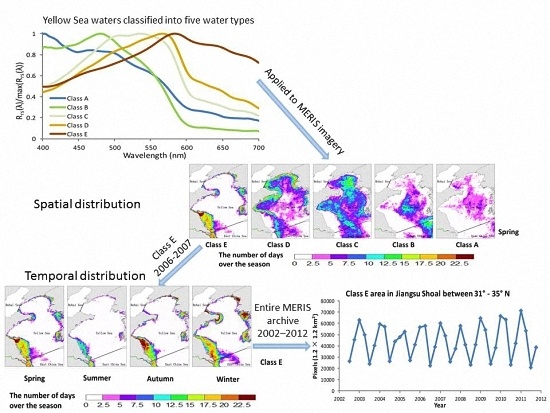Spectral Classification of the Yellow Sea and Implications for Coastal Ocean Color Remote Sensing
Abstract
:1. Introduction
2. Data and Methods
2.1. Study Area
2.2. Data Acquisition and Pre-Processing
2.2.1. In-Situ Data Sets
2.2.2. MERIS Image L2R Remote Sensing Reflectance Data
2.3. Method for the Classification of In-Situ Rrs Spectra
- Class A: Phytoplankton dominant waters. The spectral peak was at 400 nm.
- Class B: Phytoplankton and CDOM co-dominant waters. The peak band was at approximately 490 nm, and the minimum one was near 580 nm.
- Class C: Mixed waters with no dominant components. A flat peak was present at 500–550 nm, and the minimum was near 400 nm.
- Class D: Total suspended matter dominant waters. The peak was around 565 nm.
- Class E: Very high suspended sediment concentrations in water. The peak exceeded 570 nm.
3. Results
3.1. In-Situ Rrs Classification and Spectra Features
3.2. Spatio-Temporal Characteristics of the Coastal Waters
3.2.1. Distribution Features of In-Situ Reflectance and Bio-Optical Properties
- (1)
- In the middle of the Yellow Sea, the average values of Rrs were very small, i.e., lower than 0.0070 sr−1 (Figure 7a,b, Table 2), and values peaked at 400 nm or 490 nm in accordance with the appearance of Class A and Class B waters; most of the Class B spectra appeared as a feature of absorption at 443 nm (Figure 6, MYS). Optical property values were the lowest in the Yellow Sea, and a(488), c(488), and bb(488) were respectively lower than 0.175 m−1, 1.14 m−1, and 0.005 m−1 in winter (Figure 7e,f, Table 2); moreover, ad(400) and ag(400) were respectively lower than 0.1 m−1 and 0.17 m−1 in spring, 0.084 m−1 and 0.354 m−1 in summer (Figure 7g,d), and 0.045 m−1 and 0.15 m−1 in autumn. The Kd(490) was lower than 0.27 m−1 in summer. The water optical properties were mainly influenced by the warm current of the YSWC, and clear waters or Class A areas were little influenced by turbid tides from Changjiang River discharges [20,34].
- (2)
- In the north Yellow Sea, which extends from the middle of the Yellow Sea, the average values of Rrs were relatively small and lower than 0.01 sr−1 (Figure 7a,b, Table 2). Reflectance peaks appeared near 490 nm and flat peaks appeared at 500–565 nm; these were affected by non-pigmented particles and CDOM (Figure 6, NYS), similar to the features of Class B and Class C waters spectra. The north Yellow Sea optical property values were relatively low near the middle of the Yellow Sea. The average values of ad(400), aphy(400), and ag(400) were 0.084 m−1, 0.055 m−1, and 0.15 m−1 in autumn, respectively, which were larger than the values in the middle of the Yellow Sea. The relative percentage of aphy(400) was lower than ag and ad, and this could suggest that Rrs optical properties were affected by non-pigmented particles and CDOM. Kd(490) was 0.072–0.46 m−1 in spring and 0.109–0.507 m−1 in autumn ((Figure 7c), and the values were distributed as concentric circles with minimum values in the center. The water optical properties were influenced by the warm current branch of the YSWC that extends through the MYS region and the NYS region [20,34]. Four stations near the Yalu River mouth were influenced by river discharges as well as by coastal and bottom erosion processes; here, the reflectance peaked at 565 nm and values were lower than 0.025 sr−1.
- (3)
- In coastal Shandong, the average values of Rrs were relatively high, i.e., 0.01–0.02 sr−1 (Figure 7a,b, Table 2), and flat peaks appeared at 500–560 nm as well as a peak at 565 nm in accordance with the appearance of Class C and Class D waters (Figure 6, CS). According to the statistical data (Table 1), the suspended sediment and CDOM concentrations in coastal water bodies were relatively high compared to the north and middle regions of the Yellow Sea. The values of ad(400), aphy(400), and ag(400) were relative larger than the values in the north Yellow Sea, and the absorption coefficients showed contours parallel with the coastline in spring with relatively higher values in the inner 30 m isobaths than the outside ones. Additionally, the absorption coefficient isoclines were nearly perpendicular with the coastline in summer, and the values decreased from high values along the Qingdao coast to low values in the middle of the Yellow Sea (Figure 7g,d). ad(400) was 0.0439–1.878 m−1 in spring and 0.0284–0.735 m−1 in autumn. ag(400) was larger than 0.073 m−1 in spring and about 0.1188–0.244 m−1 in autumn. a(488), c(488), and bb(488) were respectively 0.1647–6.396 m−1, 0.8102–18.35 m−1, and 0.0028–0.079 m−1, and the contours were parallel with the coastline in winter (Figure 7e,f). Kd(490) was 0.08–0.94 m−1 in spring and 0.25–0.35 m−1 in summer. The water optical properties were mainly influenced by coastal currents and re-suspended sediments from shallow waters [19,34].
- (4)
- In Jiangsu shoal, the values of Rrs were higher than those in the other regions of the Yellow Sea; specifically, the values were larger than 0.015 sr−1 (Figure 7a,b, Table 2). A peak at 565 nm and a peak at wavelengths larger than 570 nm were observed in accordance with the appearance of Class D and Class E waters (Figure 6, JS). The spectra of Class D in terms of the amount were different between coastal Shandong and Jiangsu shoal; the maximum values of Rrs in Jiangsu shoal were more than 0.025 sr−1, and these were seriously influenced by suspended sediments [34,35]. ag(400) values were larger than 0.3 m−1 in the inner 10 m isobaths, and the contours were approximately parallel to the shoreline when influenced by tides and currents in spring and larger than 0.25 m−1 in summer when the maximum center of values shifted to north of the shoal (Figure 7d). ad(400) and aphy(400) were, respectively, larger than 3.5 m−1 and 0.2 m−1 in spring and larger than 0.5 m−1 and 0.17 m−1 in summer (Figure 7g). Kd(490) was larger than 2.8 m−1 in spring and 0.67 m−1 in summer. a(488), c(488), and bb(488) were respectively larger than 6.85 m−1, 30 m−1, and 0.11 m−1 in the inner 10 m isobaths, and values gradually decreased in the middle of the Yellow Sea; their contours basically paralleled the coast. The contour lines expanded in the northeast direction as a result of the northeastern flow of the Changjiang River discharges. In winter, Jiangsu shoal became a high absorption water body, and the backscattering in Jiangsu shoal was obviously stronger than that in the other areas (Figure 7e,f). The water optical properties were influenced by discharges from the Changjiang River and re-suspended sediments from shallow waters that were disturbed by the actions of coastal currents, moon-induced tides, and monsoons.
3.2.2. Classification Variation in Different Regions and Seasons
3.3. MERIS Imagery Reflectance Classification
3.3.1. Operational Classification Tree
- (1)
- Setting threshold value to preserve the valid water data. To avoid the loss of turbid water data and the removal of other water data, all reflectance pixels in the study area took part in the classification and threshold values were used. Up to 90% of the total radiance received at the sensor for most cloud-free scenes was affected by the intervening atmosphere [36], and the field spectra and MERIS matched-up site pixel spectra in Figure 2 and Figure 3 show that the B1 (413 nm) band and B2 (443 nm) band reflectances of coastal waters were less than 0.05 sr−1; the peak of reflectance at the B5 (560 nm) band was greater than 0. Because of overestimates due to atmosphere scattering at short wavelengths, B2 was chosen as the reference band and a 0.05 sr−1 threshold value was used. Additionally, positives for B5 that included most of the water spectra peaks between 413–709 nm were examined. Through the threshold values and peak bands, we were able to completely discard the pixels for cloud, glint, white caps, and other non-relevant objects.
- (2)
- Partition in water types by band peaks and band ratios. Waters were classified according to the shape of spectra, and for this, thresholds were used to assist the classification in overcoming the shifts of peaks and the influence of quantity changes in the adjacent bands caused by atmosphere correction. It is reasonable to categorize pixels to the corresponding water types based on spectra shapes by comparing band peaks with adjacent band values within 5% or 10% in practice, such as Rrs(490)/Rrs(510) < 1.05 or Rrs(490)/Rrs(560) < 1.1 for Class C when the peak is Rrs(490), and Rrs(560)/Rrs(510) < 1.1 for Class C when the peak is Rrs(560). Class E spectra peaks displayed an obvious red-shift phenomenon near 570 nm (Figure 2 and Figure 6), and the inflexion point near 600 nm was not changed very much in comparison to that for Class D. B5 and B6 band data from MERIS were obtained at 560 nm and 620 nm, respectively, and these data were useful for categorizing the pixels in which the peaks appeared; this was particularly true for over 50% of the B5 data for Class E in this paper.
3.3.2. Imagery Classification and Frequency Distribution
4. Discussion
4.1. Analysis for the Imagery Classification Results
4.2. Test of the Max-Classification on Other Turbid Waters and Comparisons with Other Operational Classification Methods
5. Conclusions
- (l)
- Yellow Sea water spectra could be divided into five categories, from clear to very turbid waters, which were termed as Class A to Class E, and these classes showed seasonal and spatial variations in four regions, namely, MYS, NYS, CS, and JS. Class E waters were mainly distributed in the estuary of the Changjiang River and in Jiangsu shoal. Class D waters were distributed along the coast of the Shandong Peninsula and along the outer edge of Class E waters in Jiangsu shoal. Class C waters were distributed in the north Yellow Sea and along the southern coast. Class B waters were mainly distributed in the central area of the Yellow Sea and north Yellow Sea. Class A waters appeared in the north Yellow Sea central region during the summer and in the middle of the Yellow Sea except in winter. Regarding the origins of the water classes, Class E waters in Jiangsu shoal were mainly due to tidal-induced bottom sediment re-suspension and terrigenous inputs. Class D waters along the coast of the Shandong Peninsula were mainly caused by turbid waters created by alongshore currents. Class C waters appeared when concentrations of suspended sediments in former Class D type waters decreased or when concentrations of suspended sediments in former Class B type waters increased. Class B waters that appeared in the middle of the Yellow Sea and in the central region of the north Yellow Sea were mainly influenced by the Yellow Sea warm current. Class A waters existed in all four seasons except for a very small area in winter; compared with Class B, these waters were less affected by suspended particle matter and chlorophyll absorption dominated the optical property characteristics.
- (2)
- The values of Rrs spectra were similar in spring and autumn, and values were highest in winter and lowest in summer. The Rrs of Jiangsu shoal was constantly at a high value all year round, and relatively low values were detected in the middle of the Yellow Sea and the central region of the north Yellow Sea. Influenced by the northward Yellow Sea warm current, the optical properties of the north Yellow Sea showed seasonal changes that were larger than those in other areas. Class D spectra values in coastal Shandong were less than those in out-layers of Class E waters characterized by low SPM concentrations. Scattering, absorption, and attenuation of water were strong in winter and weak in summer.
- (3)
- The five spectra types in the Yellow Sea were mainly categorized by the Rrs spectral peak features, which were easy to obtain from satellite products and analyze with an operational classification tree. The imagery classification frequency distribution maps showed a tendency whereby the area of Class E waters at Jiangsu shoal gradually shrank in summer and expanded in winter; this change was tremendous and the coverage during the summer was about 30% to 60% of the wintertime area size.
Acknowledgments
Author Contributions
Conflicts of Interest
References
- Robinson, I.S.; Antoine, D.; Darecki, M.; Gorringe, P.; Pettersson, L.; Ruddick, K.; Santoleri, R.; Siegel, H.; Vincent, P.; Wernand, M.; et al. Remote Sensing of Shelf Sea Ecosystems—State of the Art and Perspective (Vol. 12); European Science Foundation Marine Board: Ostend, Belgium, 2008; pp. 9–18. [Google Scholar]
- Wang, M.; Ahn, J.H.; Jiang, L.; Shi, W.; Son, S.; Park, Y.J.; Ryu, J.H. Ocean color products from the Korean Geostationary Ocean Color Imager (GOCI). Opt. Express 2013, 21, 3835–3849. [Google Scholar] [CrossRef] [PubMed]
- Blondeau–Patissier, D.; Gower, J.F.R.; Dekker, A.G.; Phinn, S.R.; Brando, V.E. A review of ocean color remote sensing methods and statistical techniques for the detection, mapping and analysis of phytoplankton blooms in coastal and open oceans. Prog. Oceanogr. 2014, 123, 123–144. [Google Scholar] [CrossRef] [Green Version]
- Cui, T.; Zhang, J.; Sun, L.; Jia, Y.; Zhao, W.; Wang, Z.; Meng, J. Satellite monitoring of massive green macroalgae bloom GMB: Imaging ability comparison of multi-source data and drifting velocity estimation. Int. J. Remote Sens. 2012, 33, 5513–5527. [Google Scholar] [CrossRef]
- Stewart, K.R.; Lewison, R.L.; Dunn, D.C.; Bjorkland, R.H.; Kelez, S.; Halpin, P.N.; Crowder, L.B. Characterizing fishing effort and spatial extent of coastal fisheries. PLoS ONE 2010, 5, e14451. [Google Scholar] [CrossRef] [PubMed]
- Lahet, F.; Ouillon, S.; Forget, P. Colour classification of coastal waters of the Ebro river plume from spectral reflectances. Int. J. Remote Sens. 2001, 22, 1639–1664. [Google Scholar] [CrossRef]
- Mobley, C.D. Light and Water-Radiative Transfer in Natural Waters; Academic Press: San Diego, CA, USA, 1994; pp. 86–100. [Google Scholar]
- Roesler, C.S.; Perry, M.J. In situ phytoplankton absorption, fluorescence emission, and particulate backscattering spectra determined from reflectance. J. Geophys. Res. 1995, 100, 13279–13294. [Google Scholar] [CrossRef]
- Arnone, R. Remote sensing of ocean color in coastal and other optically-complex waters. In Reports of the International Ocean-Colour Coordinating Group, No. 3; Sathyendranath, S., Ed.; IOCCG: Dartmouth, NS, Canada, 2000; pp. 34–36. [Google Scholar]
- Lubac, B.; Loisel, H. Variability and classification of remote sensing reflectance spectra in the eastern English Channel and southern North Sea. Remote Sens. Environ. 2007, 110, 45–58. [Google Scholar] [CrossRef]
- Vantrepotte, V.; Loisel, H.; Dessailly, D.; Mériaux, X. Optical classification of contrasted coastal waters. Remote Sens. Environ. 2012, 123, 306–323. [Google Scholar] [CrossRef]
- Moore, T.S.; Campbell, J.W.; Dowell, M.D. A class-based approach to characterizing and mapping the uncertainty of the MODIS ocean chlorophyll product. Remote Sens. Environ. 2009, 113, 2424–2430. [Google Scholar] [CrossRef]
- Mélin, F.; Vantrepotte, V. How optically diverse is the coastal ocean? Remote Sens. Environ. 2015, 160, 235–251. [Google Scholar] [CrossRef]
- Jerlov, N.G. Marine Optics; Elsevier: Amsterdam, The Netherlands, 1976; pp. 118–122. [Google Scholar]
- Prieur, L.; Sathyendranath, S. An optical classification of coastal and oceanic waters based on the specific spectral absorption curves of phytoplankton pigments, dissolved organic matter, and other particulate materials. Limnol. Oceanogr. 1981, 26, 671–689. [Google Scholar] [CrossRef]
- Werdell, P.J.; Bailey, S.W. An improved in-situ bio-optical data set for ocean color algorithm development and satellite data product validation. Remote Sens. Environ. 2005, 98, 122–140. [Google Scholar] [CrossRef]
- Wernand, M.R.; Hommersom, A.; van der Woerd, H.J. MERIS-based ocean colour classification with the discrete Forel–Ule scale. Ocean Sci. 2013, 9, 477–487. [Google Scholar] [CrossRef] [Green Version]
- Franz, B.A.; Werdell, P.J.; Meister, G.; Kwiatkowska, E.J.; Bailey, S.W.; Ahmad, Z.; McClain, C.R. MODIS Land Bands for Ocean Remote Sensing Applications. In Proceedings of the Ocean Optics XVIII, Montreal, QC, Canada, 9–13 October 2006.
- Wang, Y. Marine Geography of China; Marine Press: Beijing, China, 1996. [Google Scholar]
- Ichikawa, H.; Beardsley, R. The current system in the Yellow and East China Seas. J. Oceanogr. 2002, 58, 77–92. [Google Scholar] [CrossRef]
- Mueller, J.L.; Fargion, G.S.; McClain, C.R.; Mueller, J.; Brown, S.; Clark, D.; Johnson, B.; Yoon, H.; Lykke, K.; Flora, S. Ocean Optics Protocols for Satellite Ocean Color Sensor Validation Volume VI: Special Topics in Ocean Optics Protocols, Part 2 (Vol. 211621); NASA: Washington, DC, USA, 2004.
- Tang, J.; Wang, X.; Song, Q.; Li, T.; Chen, J.; Huang, H.; Ren, J. The statistic inversion algorithms of water constituents for the Huanghai Sea and the East China Sea. Acta Ocean. Sin. 2004, 23, 617–626. [Google Scholar]
- Zhang, M.; Tang, J.; Song, Q.; Dong, Q. Backscattering ratio variation and its implications for studying particle composition: A case study in Yellow and East China seas. J. Geophys. Res. 2010, 115, C12014. [Google Scholar] [CrossRef]
- Wang, X.; Li, T.; Zhou, H.; Bi, D. Discussion on ocean opticas properties of Chinese offshore and its distribution characteristics. Period. Ocean Univ. China 2014, 44, 104–111. [Google Scholar]
- Mueller, J.L.; Fargion, G.S. HPLC Phytoplankton Pigments: Sampling, Laboratory Methods, and Quality Assurance Procedures Ocean Optics Protocols For Satellite Ocean Color Sensor Validation (Vol. TM-2002); NASA: Washington, DC, USA, 2003.
- Roesler, C.S. Theoretical and experimental approaches to improve the accuracy of particulate absorption coefficients derived from the quantitative filter technique. Limnol. Oceanogr. 1998, 43, 1649–1660. [Google Scholar] [CrossRef]
- Wetlabs ACS User’s Guide, 2009. Available online: http://www.wetlabs.com/products/ac/acall.htm (accessed on 9 January 2015).
- Zaneveld, J.R.V.; Kitchen, J.C.; Moore, C.C. Scattering error correction of reflecting–tube absorption meters. Proc. SPIE 1994, 2258, 44–55. [Google Scholar] [CrossRef]
- Maffione, R.A.; Dana, D.R. Instruments and methods for measuring the backward-scattering coefficient of ocean waters. Appl. Opt. 1997, 36, 6057–6067. [Google Scholar] [CrossRef] [PubMed]
- Gordon, H.R.; McCluney, W.R. Estimation of the depth of sunlight penetration in the sea for remote sensing. Appl. Opt. 1975, 14, 413–416. [Google Scholar] [CrossRef] [PubMed]
- Doerffer, R. Protocols for the Validation of MERIS Water Products; Doc. No. PO-TN-MEL-GS-0043; European Space Agency: Geesthacht, Germany, 2002. [Google Scholar]
- Cui, T.; Zhang, J.; Tang, J.; Sathyendranath, S.; Groom, S.; Ma, Y.; Zhao, W.; Song, Q. Assessment of satellite ocean color products of MERIS, MODIS and SeaWiFS along the East China Coast (in the Yellow Sea and East China Sea). ISPRS J. Photogram. Remote Sens. 2014, 87, 137–151. [Google Scholar] [CrossRef]
- Ye, H.; Li, T. Study on water mass spectral property with supervised classification method. Ocean Tech. 2009, 28, 96–100. [Google Scholar]
- Li, T. Optical Properties and Remote Sensing of China Coastal Waters; Marine Press: Beijing, China, 2012. [Google Scholar]
- Ahn, Y. Development of an inverse model from ocean reflectance. Marine Tech. Soc. J. 1999, 33, 69–80. [Google Scholar] [CrossRef]
- Gordon, H.R.; Du, T.; Zhang, T. Remote sensing of ocean color and aerosol properties: Resolving the issue of aerosol absorption. Appl. Opt. 1997, 36, 8670–8684. [Google Scholar] [CrossRef] [PubMed]
- Wang, M.; Shi, W. The NIR-SWIR combined atmospheric correction approach for MODIS ocean color data processing. Opt. Express 2007, 15, 15722–15733. [Google Scholar] [CrossRef] [PubMed]
- Nordkvist, K.; Loisel, H.; Gaurier, L.D. Cloud masking of SeaWiFS images over coastal waters using spectral variability. Opt. Express 2009, 17, 12246–12258. [Google Scholar] [CrossRef] [PubMed]
- He, X.; Bai, Y.; Pan, D.; Tang, J.; Wang, D. Atmospheric correction of satellite ocean color imagery using the ultraviolet wavelength for highly turbid waters. Opt. Express 2012, 20, 20754–20770. [Google Scholar] [CrossRef] [PubMed]
- Bricaud, A.; Stramski, D. Spectral absorption coefficients of living phytoplankton and nonalgal biogenous matter: A comparison between the Peru upwelling area and the Sargasso Sea. Limnol. Oceanogr. 1990, 35, 562–582. [Google Scholar] [CrossRef]
- Zhu, J.; Zhou, H.; Li, T.; Han, B. Study on applicability of pathlength amplification correction factor with T-R method based on Chlorella vulgaris. Ocean Tech. 2010, 29, 40–45. [Google Scholar]
- LISST-100X Particle Size Analyzer, User’s Manual Version 5.0, Sequoia Scientific, Inc. Available online: http://www.sequoiasci.com/product/lisst-100x/ (accessed on 30 November 2015).
- McKee, D.; Piskozub, J.; Röttgers, R.; Reynolds, R.A. Evaluation and improvement of an iterative scattering correction scheme for in situ absorption and attenuation measurements. J. Atm. Oceanic Tech. 2013, 30, 1527–1541. [Google Scholar] [CrossRef]
- Toole, D.A.; Siegel, D.A. Modes and mechanisms of ocean color variability in the Santa Barbara Channel. J. Geophys. Res. 2001, 106, 26985–27000. [Google Scholar] [CrossRef]
- Moore, T.S.; Dowell, M.D.; Bradt, S.; Ruiz Verdu, A. An optical water type framework for selecting and blending retrievals from bio–optical algorithms in lakes and coastal waters. Remote Sens. Environ. 2014, 143, 97–111. [Google Scholar] [CrossRef] [PubMed]
- Doxaran, D.; Cherukuru, N.; Lavender, S.J. Apparent and inherent optical properties of turbid estuarine waters: Measurements, empirical quantification relationships, and modeling. Appl. Opt. 2006, 45, 2310–2324. [Google Scholar] [CrossRef] [PubMed]
- Moore, T.S.; Campbell, J.W.; Feng, H. A fuzzy logic classification scheme for selecting and blending satellite ocean color algorithms. IEEE. Trans. Geosci. Remote Sens. 2001, 39, 1764–1776. [Google Scholar] [CrossRef]
- Ainsworth, E.J.; Jones, I.S. Radiance spectra classification from the Ocean color and Temperature Scanner on ADEOS. IEEE. Trans. Geosci. Remote Sens. 1999, 37, 1645–1656. [Google Scholar] [CrossRef]
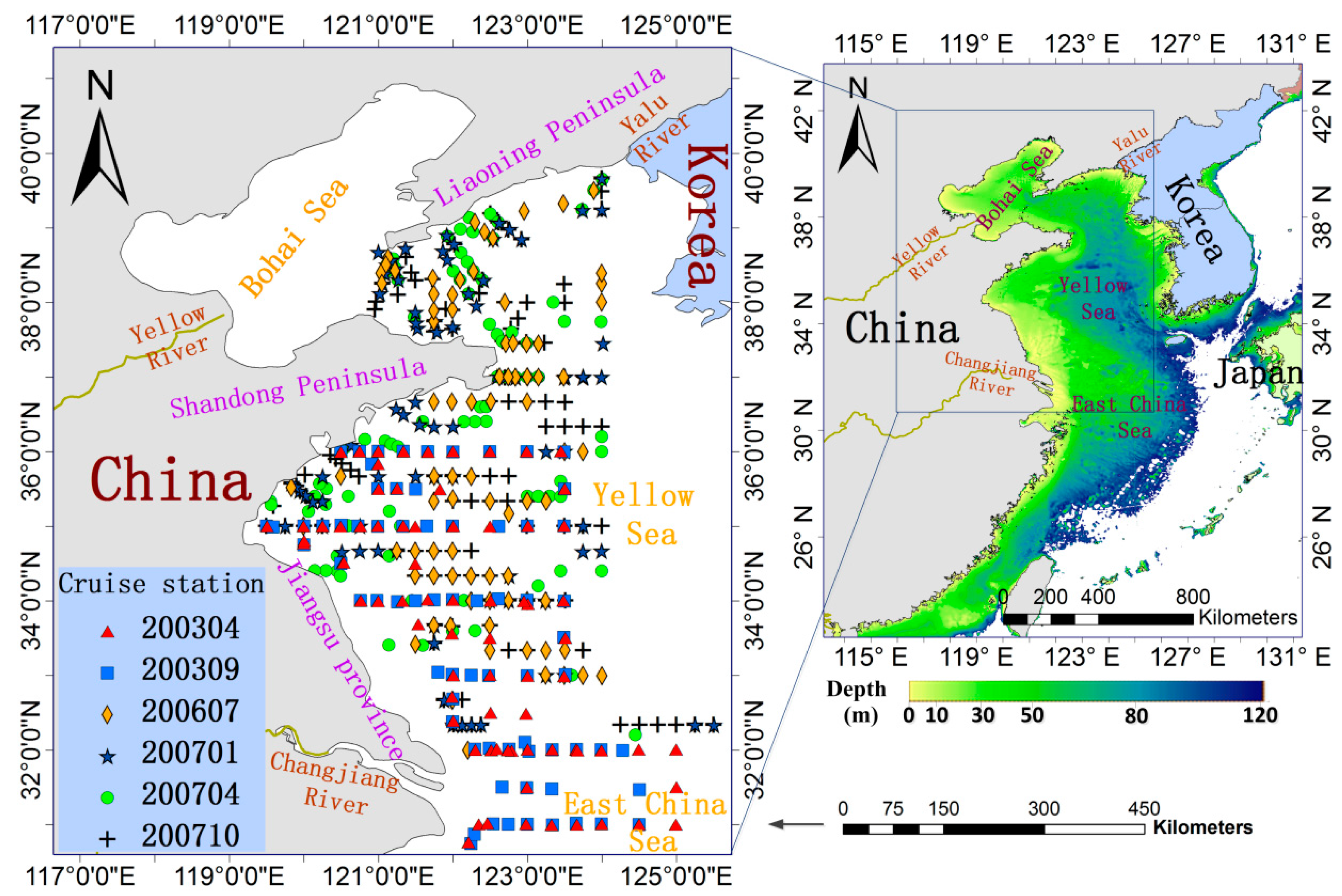
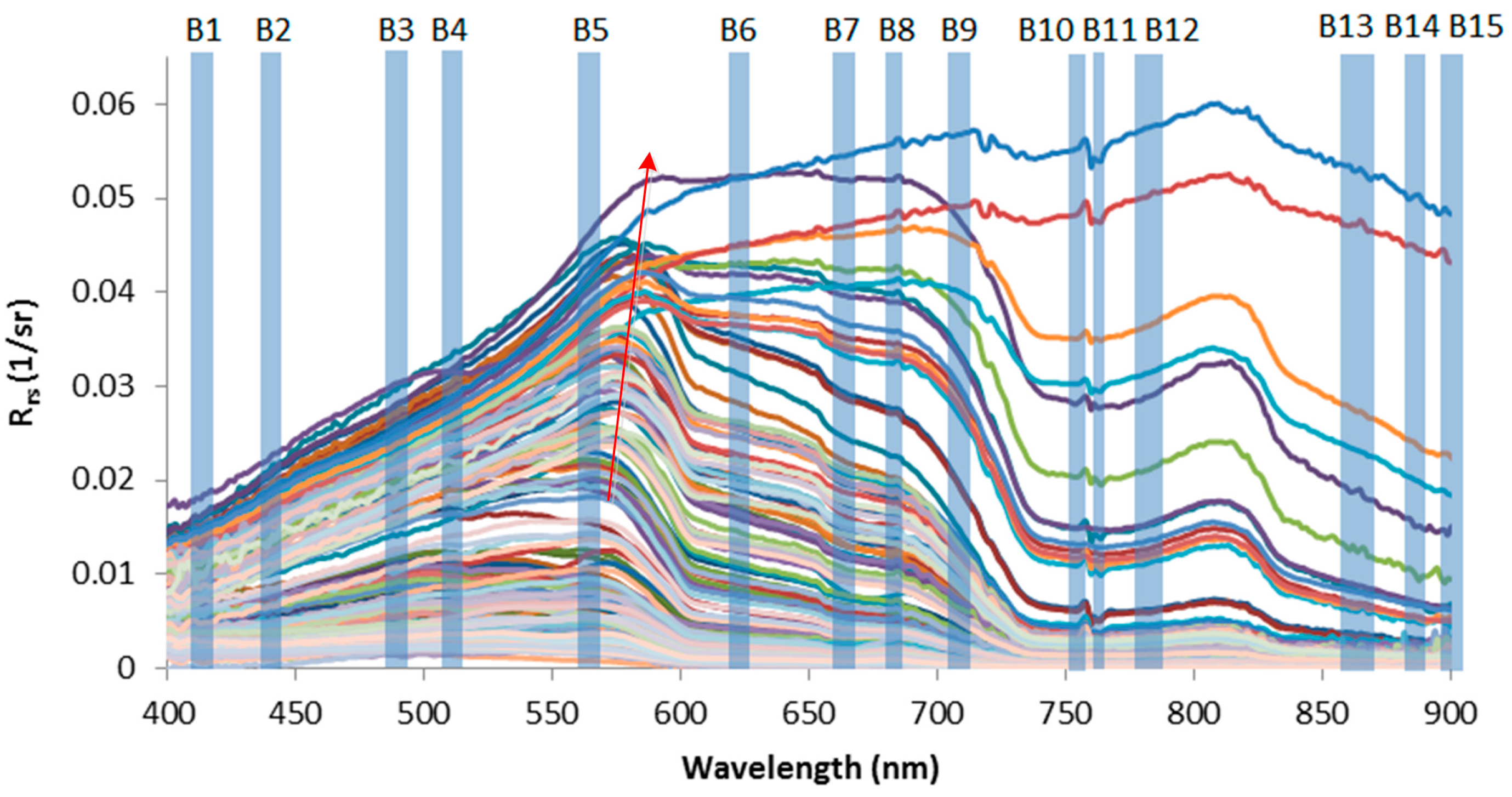
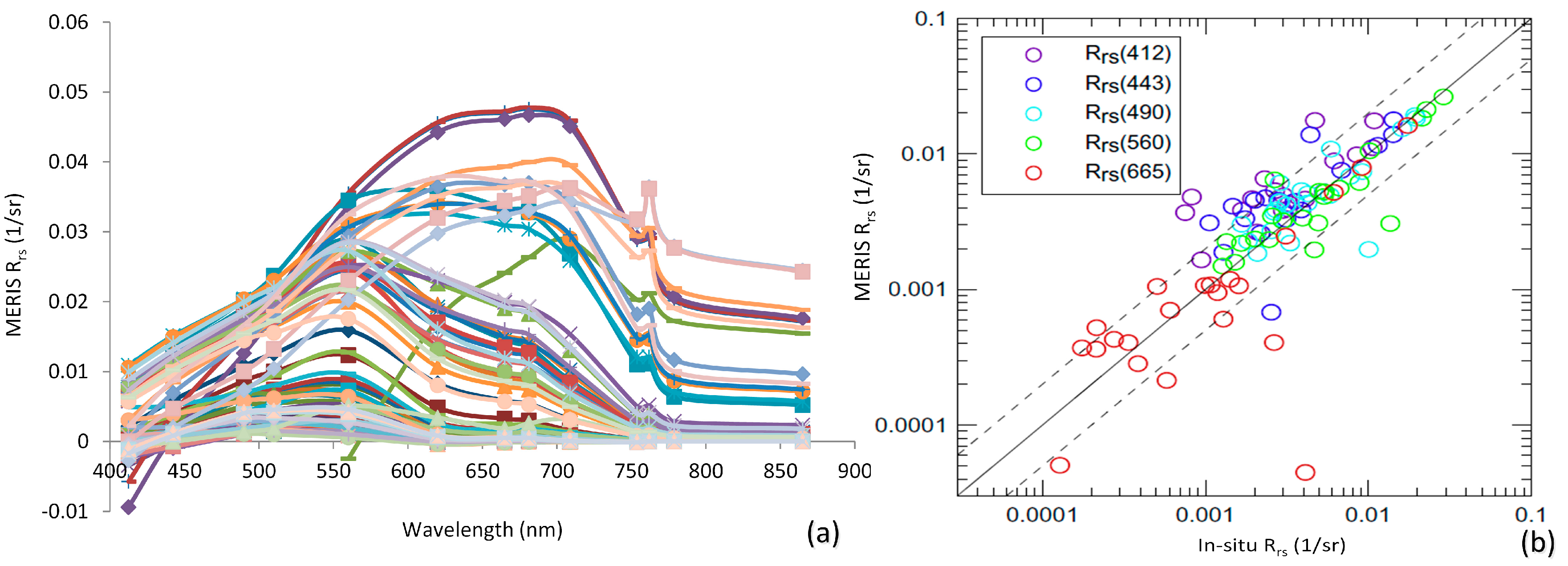
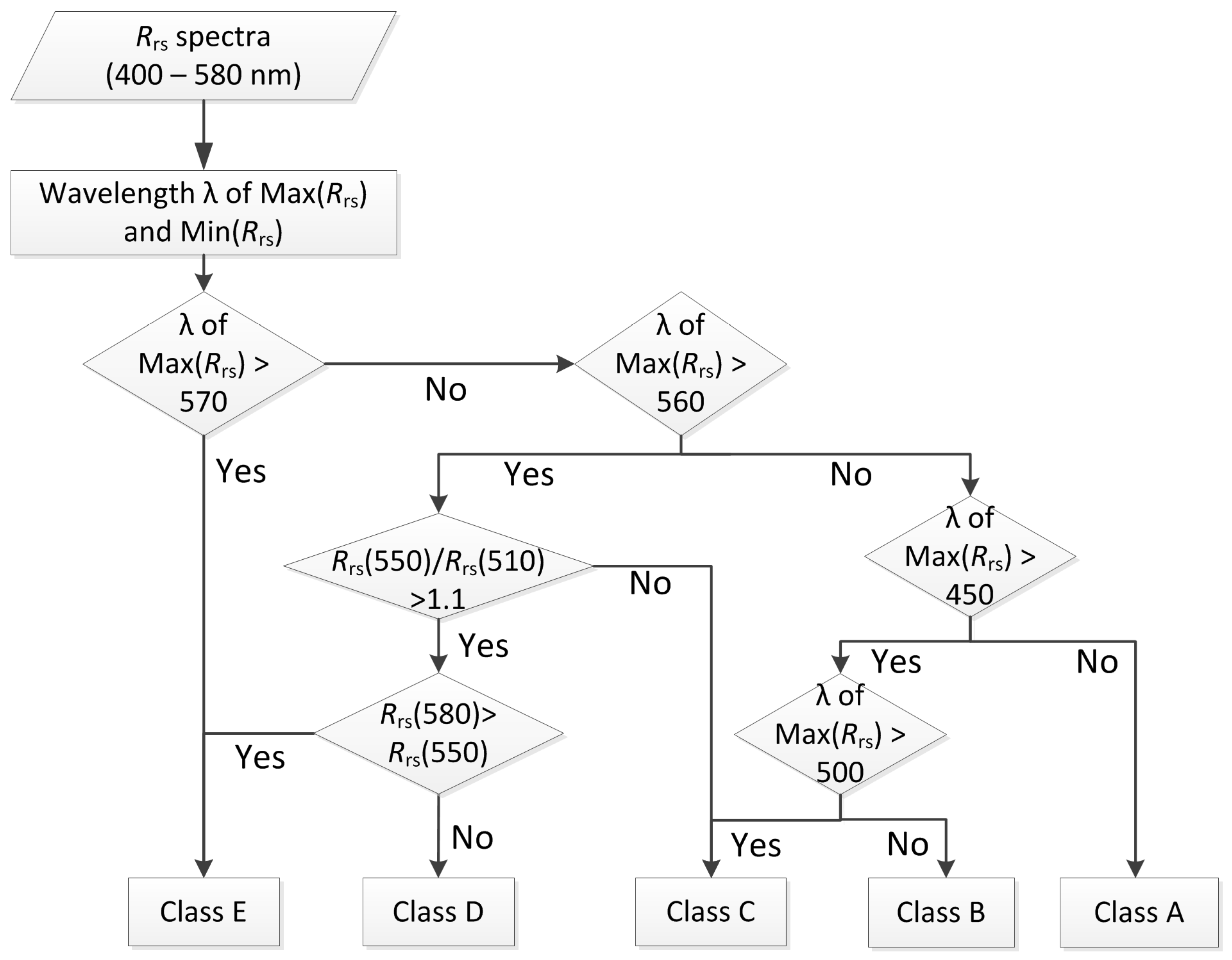
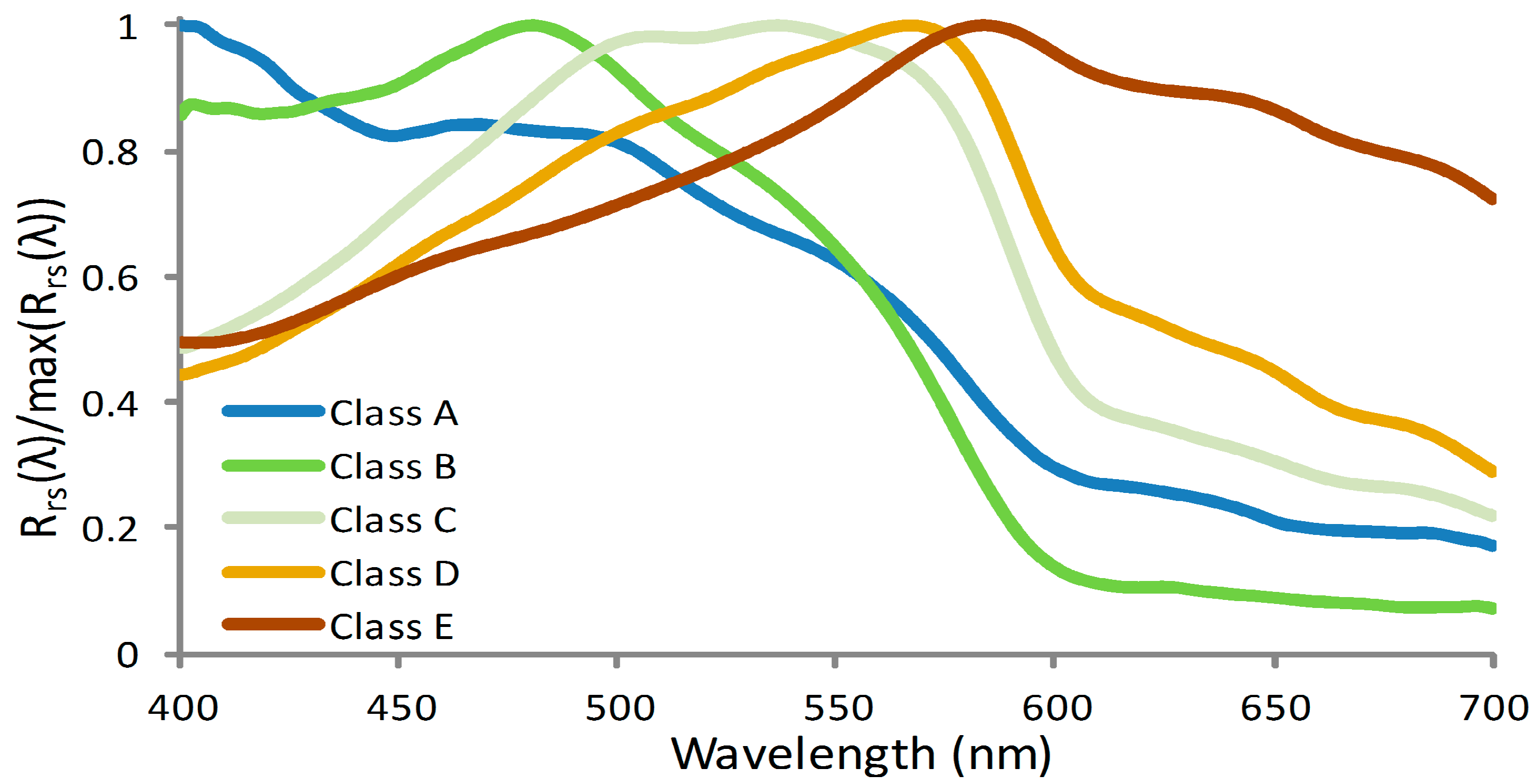
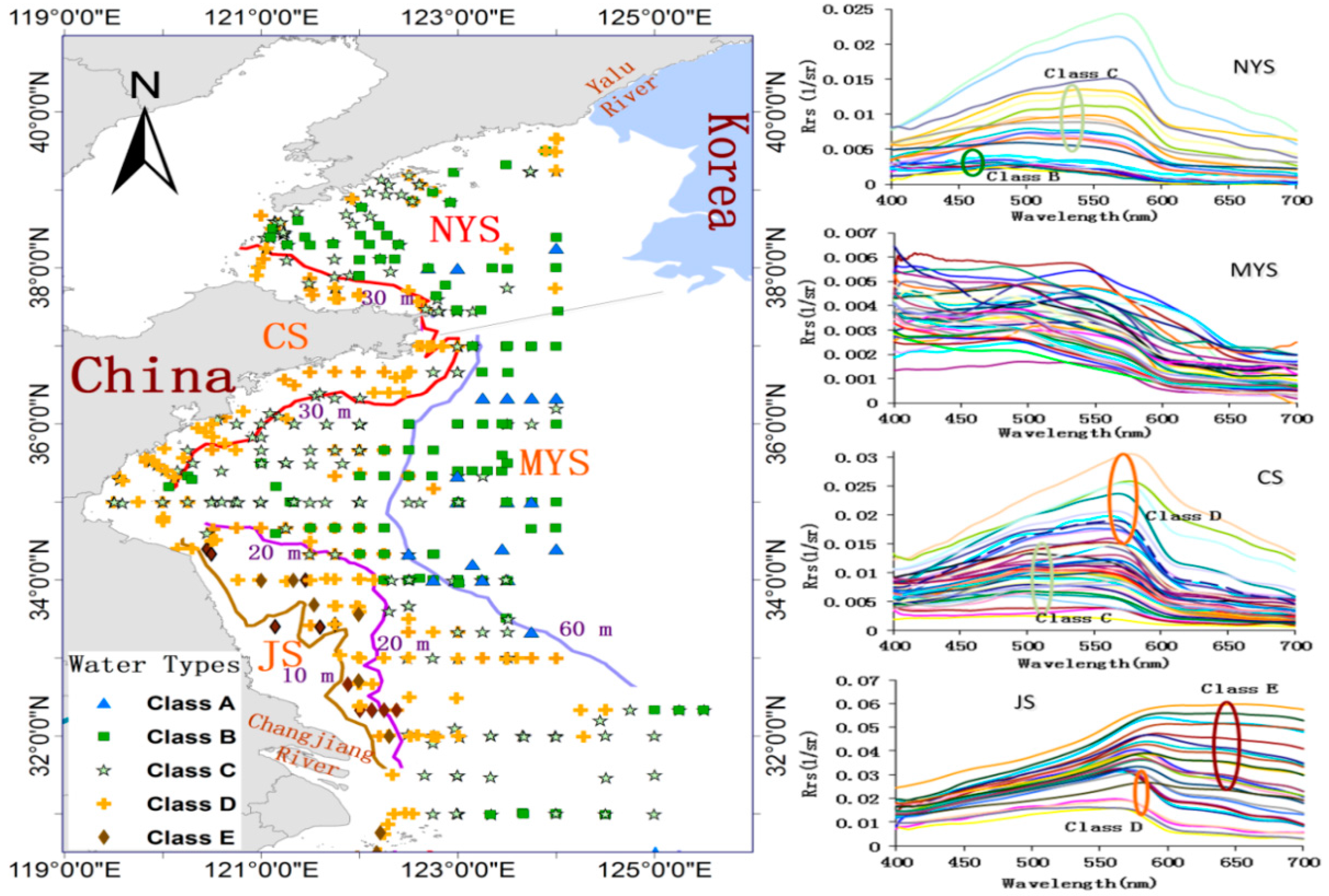

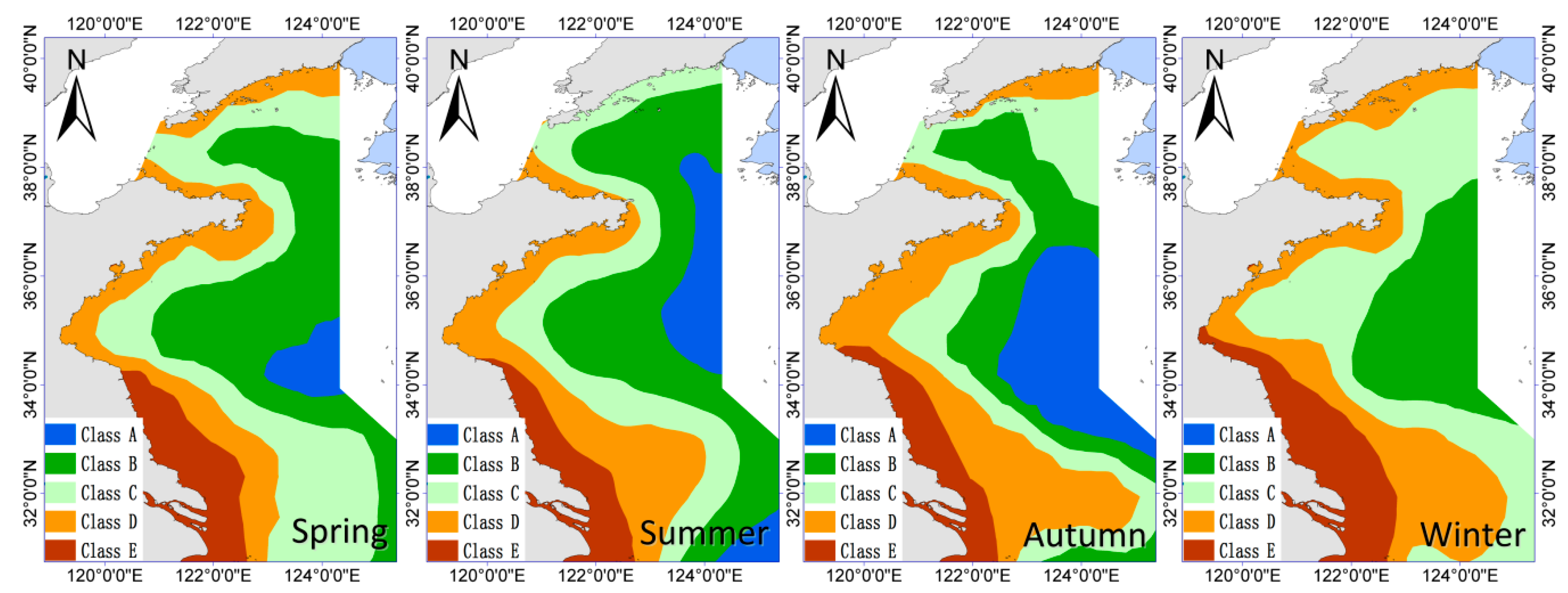
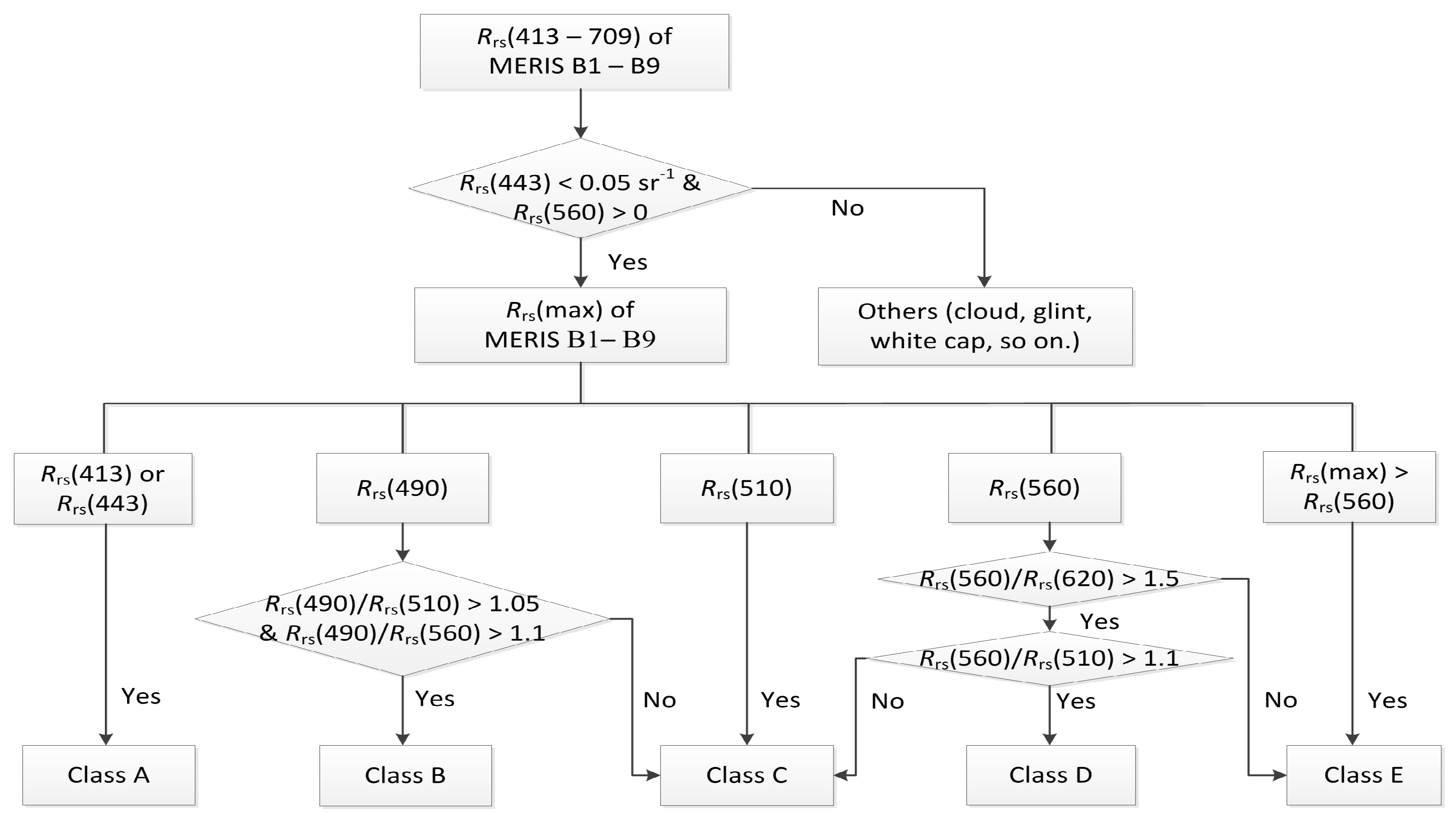
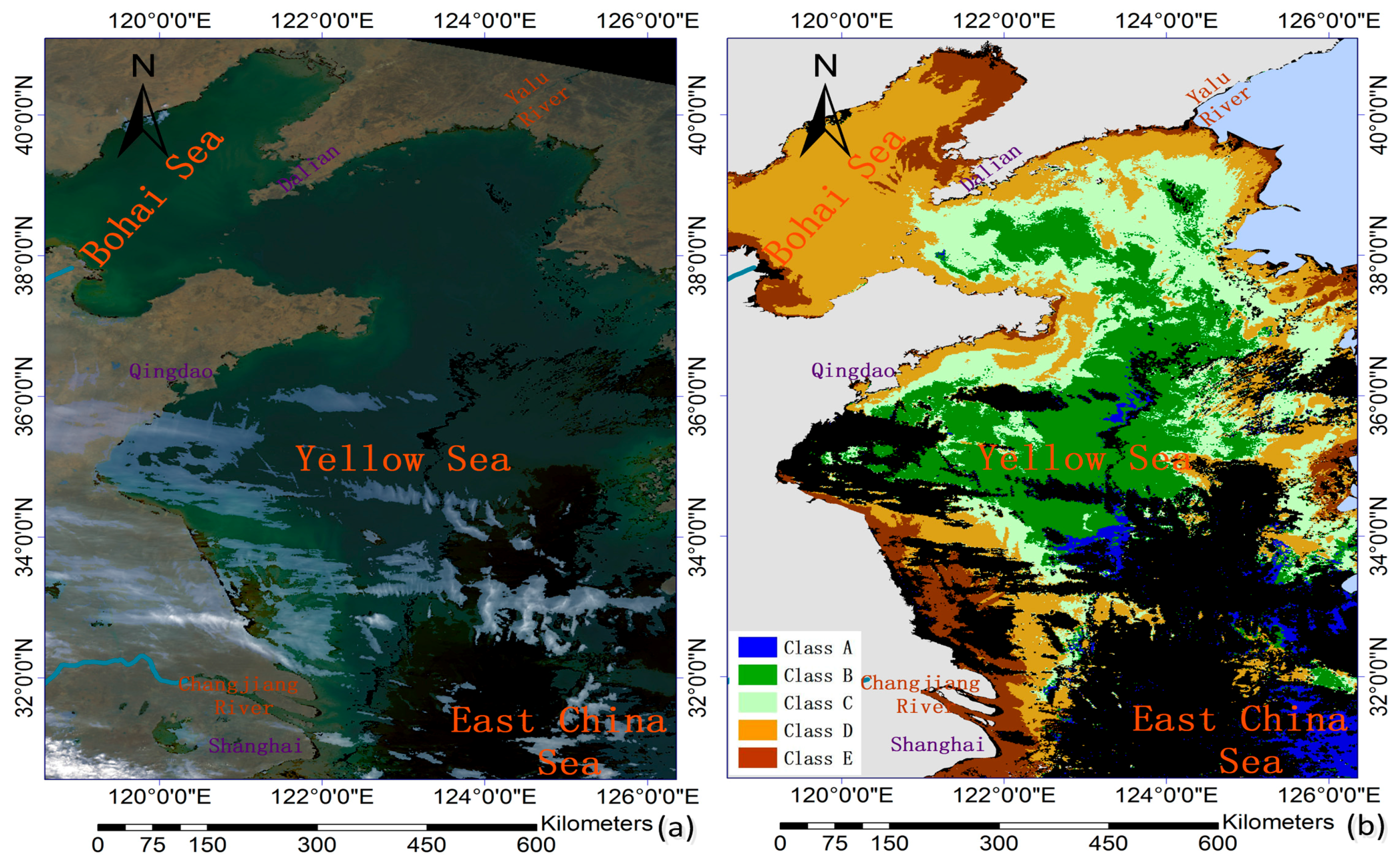
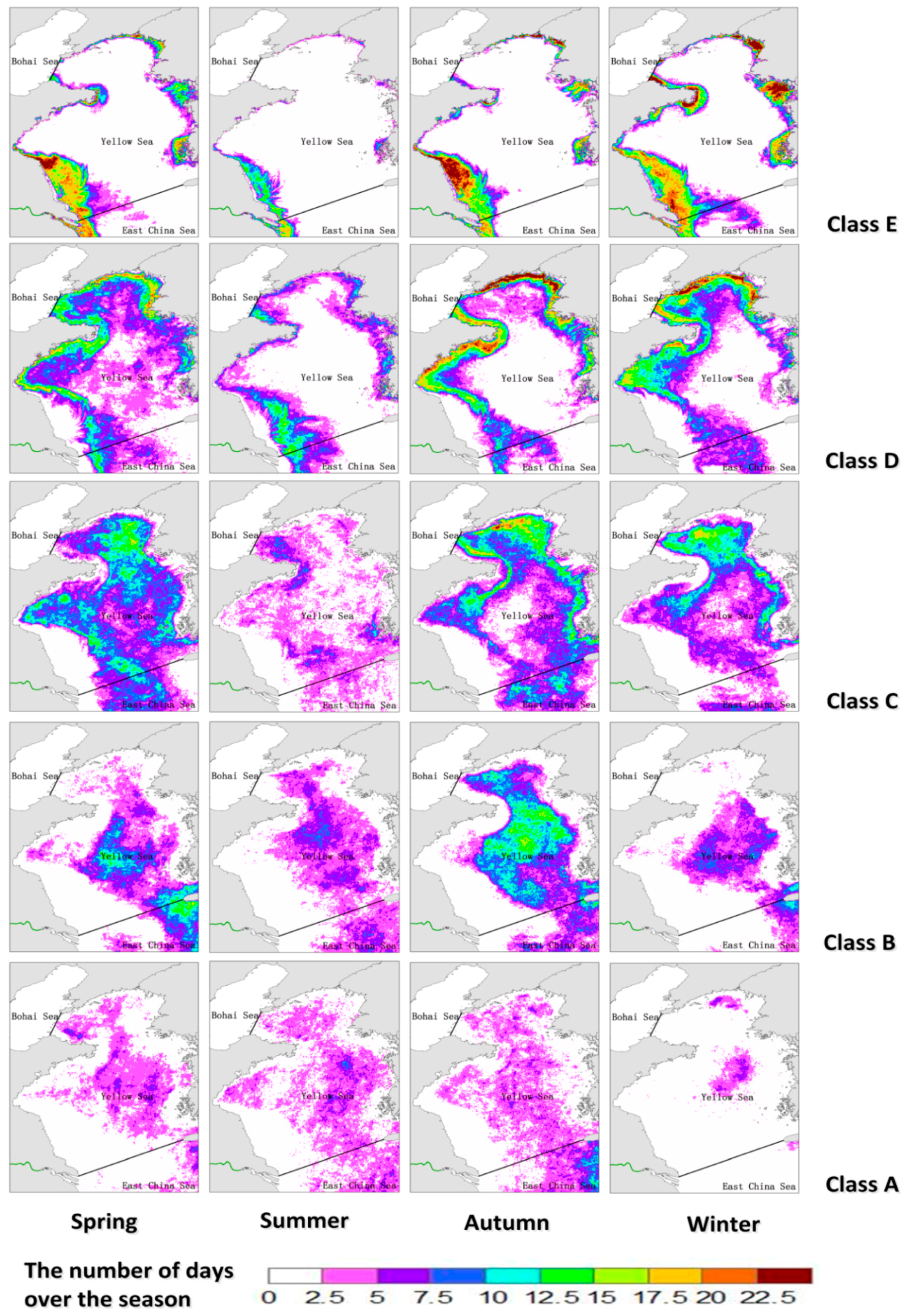
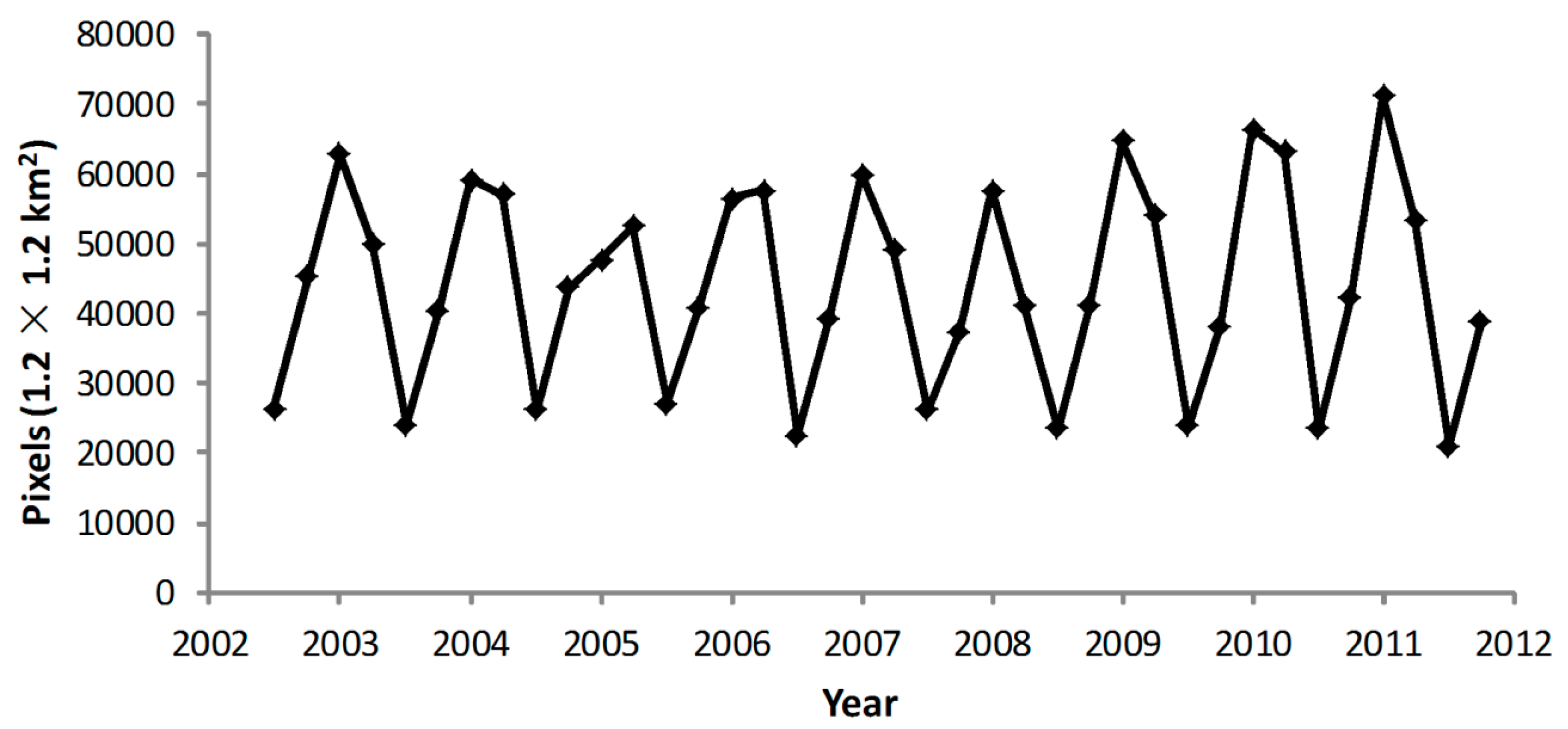
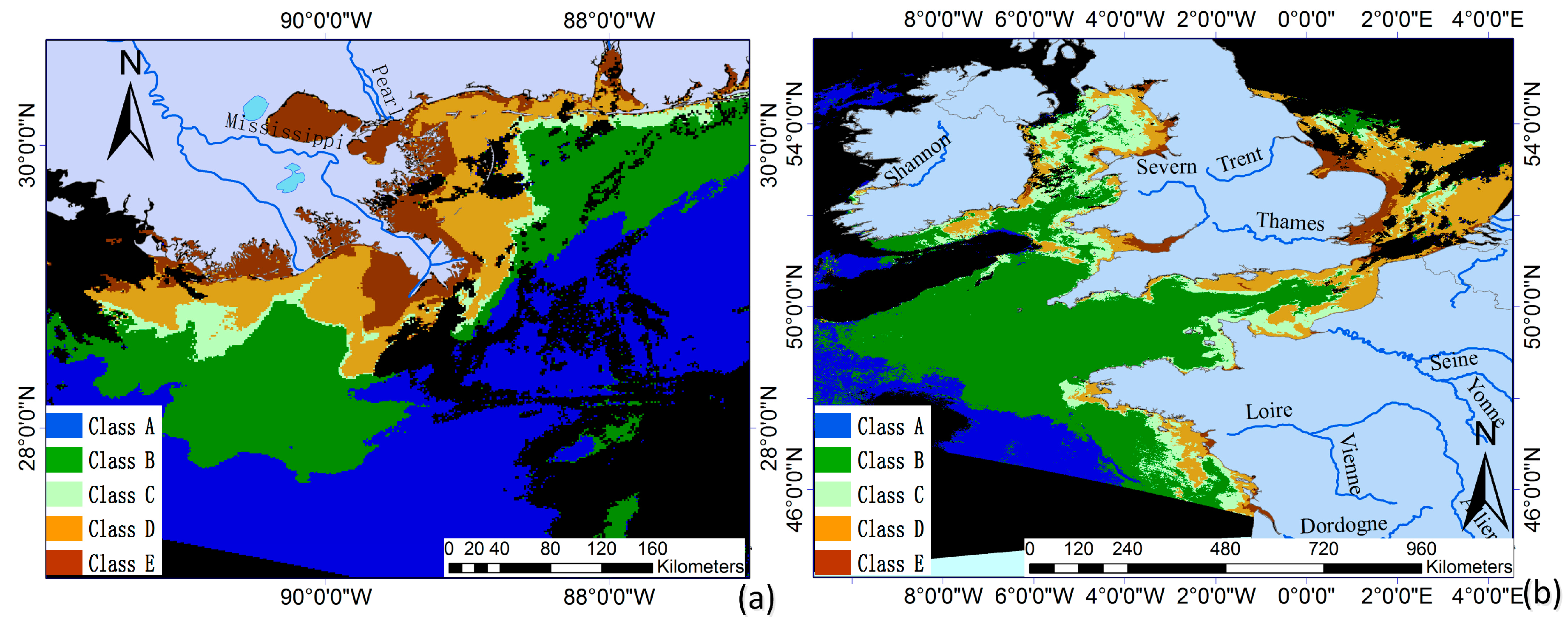
| Class | Statistic | Chl a (μg/L) | CDOM (1/m) | SPM (mg/L) | Secchi Depth (m) | Forel–Ule |
|---|---|---|---|---|---|---|
Class A | Min–Max | 0.088–1.614 | 0.005–0.107 | 0.2–4.8 | 7–21 | 4–7 |
| Median | 0.306 | 0.054 | 0.65 | 12 | 6 | |
| Avg. (Std.) | 0.456 (0.391) | 0.048 (0.038) | 1.515 (1.53) | 13 (3.7) | 6 (0.95) | |
| N = 27 | 18 | 8 | 14 | 26 | 26 | |
Class B | Min–Max | 0.117–2.23 | 0.0086–0.415 | 0.4–16.9 | 4–17 | 5–11 |
| Median | 0.48 | 0.060525 | 2.1175 | 9 | 7 | |
| Avg. (Std.) | 0.618 (0.486) | 0.0668 (0.063) | 2.798 (3.34) | 9.63 (3.63) | 7.13 (1.57) | |
| N = 167 | 81 | 60 | 62 | 126 | 126 | |
Class C | Min–Max | 0.159–6.23 | 0.0105–0.2025 | 0.7–18.9 | 2.8–13 | 6–14 |
| Median | 0.841 | 0.068 | 2.525 | 6 | 8 | |
| Avg. (Std.) | 1.088 (0.90) | 0.0674 (0.039) | 3.357 (4.97) | 6.03 (2.57) | 8.84 (1.89) | |
| N = 185 | 125 | 90 | 94 | 148 | 147 | |
Class D | Min–Max | 0.22–8.9 | 0.0327–1.11 | 2.1–78.7 | 1–10 | 7–18 |
| Median | 1.07 | 0.1045 | 12.85 | 2.75 | 12 | |
| Avg. (Std.) | 1.56 (1.49) | 0.111 (0.056) | 8.22 (10.69) | 3.96 (2.2) | 9.96 (2.46) | |
| N = 211 | 150 | 108 | 120 | 194 | 192 | |
Class E | Min–Max | 0.19–2.87 | 0.0725–0.86 | 19–1762 | 0.1–1.2 | 18–21 |
| Median | 0.645 | 0.119 | 104.9 | 0.4 | 20 | |
| Avg. (Std.) | 0.844 (0.61) | 0.18 (0.21) | 110.7 (374.6) | 0.31 (0.36) | 19.85 (1.9) | |
| N = 28 | 20 | 14 | 20 | 22 | 22 |
| Regions | Seasons | Rrs(490) (sr−1) | Kd(490) (m−1) | a(488) (m−1) | c(488) (m−1) | bb(488) (m−1) | ad(400) (m−1) | ag(400) (m−1) | aphy(400) (m−1) |
|---|---|---|---|---|---|---|---|---|---|
| The middle of Yellow Sea (MYS) | Spring | 0.0021–0.010 | 0.0699–0.214 | 0.0496–0.137 | 0.3627–1.213 | 0.0058–0.016 | 0.0113–0.106 | 0.0701–0.166 | 0.0143–0.121 |
| (N = 22) | 0.0059 (0.004) | 0.1357 (0.050) | 0.0805 (0.025) | 0.7659 (0.297) | 0.0105 (0.004) | 0.0508 (0.025) | 0.1132 (0.022) | 0.0570 (0.030) | |
| Summer | 0.0017–0.005 | 0.1361–0.270 | 0.0352–0.120 | 0.2685–0.938 | 0.0007–0.004 | 0.0168–0.084 | 0.1623–0.354 | 0.0166–0.080 | |
| (N = 13) | 0.0035 (0.001) | 0.1976 (0.051) | 0.0810 (0.037) | 0.5754 (0.287) | 0.0021 (0.001) | 0.0485 (0.028) | 0.2512 (0.075) | 0.0422 (0.024) | |
| Autumn | 0.0015–0.009 | 0.1006–0.204 | 0.0763–0.165 | 0.2046–0.717 | 0.003–0.0056 | 0.0108–0.045 | 0.100–0.155 | 0.0112–0.068 | |
| (N = 37) | 0.0046 (0.002) | 0.1345 (0.034) | 0.1029 (0.025) | 0.3452 (0.142) | 0.0038 (0.001) | 0.0241 (0.011) | 0.1231 (0.015) | 0.0273 (0.016) | |
| Winter | 0.0030–0.013 | 0.0192–0.175 | 0.2588–1.14 | 0.0006–0.0051 | |||||
| (N = 15) | 0.0064 (0.007) | 0.0752 (0.035) | 0.4692 (0.28) | 0.0015 (0.001) | |||||
| North Yellow Sea (NYS) | Spring | 0.0026–0.019 | 0.072–0.462 | 0.043–0.043 | 0.075–0.238 | 0.010–0.121 | |||
| (N = 29) | 0.0066 (0.003) | 0.207 (0.098) | 0.116 (0.072) | 0.144 (0.047) | 0.051 (0.035) | ||||
| Summer | 0.0018–0.009 | ||||||||
| (N = 25) | 0.0036 (0.002) | ||||||||
| Autumn | 0.0007–0.011 | 0.109–0.5074 | 0.015–0.313 | 0.101–0.259 | 0.0041–0.229 | ||||
| (N = 27) | 0.0045 (0.002) | 0.2183 (0.128) | 0.0844 (0.088) | 0.1532 (0.048) | 0.0554 (0.042) | ||||
| Winter | 0.0025–0.020 | ||||||||
| (N = 19) | 0.0096 (0.004) | ||||||||
| Coastal Shandong (CS) | Spring | 0.0077–0.028 | 0.0810–0.944 | 0.1180–0.305 | 1.356–3.628 | 0.0266–0.093 | 0.0439–1.878 | 0.0733–0.265 | 0.0189–0.122 |
| (N = 22) | 0.0157 (0.006) | 0.4190 (0.294) | 0.2040 (0.094) | 2.121 (0.632) | 0.0576 (0.033) | 0.3764 (0.455) | 0.1566 (0.049) | 0.0486 (0.033) | |
| Summer | 0.0021–0.016 | 0.2591–0.358 | 0.1163–1.080 | 0.7996–12.67 | 0.0024–0.069 | 0.0684–0.116 | 0.2082–0.399 | 0.0347–0.156 | |
| (N = 13) | 0.0104 (0.003) | 0.2959 (0.054) | 0.4754 (0.426) | 4.6003 (5.51) | 0.0196 (0.028) | 0.0892 (0.020) | 0.2888 (0.082) | 0.0776 (0.056) | |
| Autumn | 0.0028–0.019 | 0.1770–1.304 | 0.1373–0.230 | 0.5018–2.823 | 0.0053–0.049 | 0.0284–0.735 | 0.1188–0.244 | 0.0496–0.165 | |
| (N = 27) | 0.0114 (0.005) | 0.5395 (0.349) | 0.1701 (0.052) | 1.031 (0.313) | 0.0201 (0.025) | 0.2542 (0.225) | 0.1750 (0.037) | 0.0888 (0.036) | |
| Winter | 0.008–0.0294 | 0.1647–6.396 | 0.8102–18.35 | 0.0028–0.079 | |||||
| (N = 21) | 0.0184 (0.005) | 2.1446 (2.023) | 5.795 (4.785) | 0.0249 (0.025) | |||||
| Jiangsu shoal (JS) | Spring | 0.0153–0.030 | 0.4483–8.411 | 0.2824–8.037 | 4.4842–51.86 | 0.1129–3.421 | 0.2948–16.73 | 0.2191–0.363 | 0.0338–1.113 |
| (N = 30) | 0.0227 (0.013) | 2.8165 (2.86) | 1.9481 (2.382) | 23.126 (17.7) | 1.2176 (1.170) | 3.5573 (4.33) | 0.2687 (0.044) | 0.2063 (0.265) | |
| Summer | 0.0143–0.024 | 0.4195–1.043 | 0.4600–14.67 | 3.4908–45.49 | 0.0040–14.86 | 0.0870–0.569 | 0.2570–0.394 | 0.0408–0.428 | |
| (N = 13) | 0.0197 (0.005) | 0.6732 (0.234) | 6.7510 (7.331) | 24.375 (13.94) | 0.0660 (0.072) | 0.4167 (0.175) | 0.3031 (0.053) | 0.1660 (0.141) | |
| Autumn | 0.0161–0.028 | 0.7204–2.393 | 0.2664–1.812 | 3.5162–27.44 | 0.0761–1.049 | 0.2859–3.571 | 0.2752–0.399 | 0.0278–0.307 | |
| (N = 25) | 0.0219 (0.003) | 1.3317 (0.526) | 0.7531 (0.517) | 11.237 (8.102) | 0.3458 (0.322) | 1.1655 (0.873) | 0.2890 (0.040) | 0.1160 (0.095) | |
| Winter | 0.0161–0.032 | 0.3271–18.25 | 2.7189–53.46 | 0.0124–0.193 | |||||
| (N = 14) | 0.0265 (0.005) | 4.5309 (5.368) | 24.460 (18.66) | 0.0964 (0.061) |
© 2016 by the authors; licensee MDPI, Basel, Switzerland. This article is an open access article distributed under the terms and conditions of the Creative Commons by Attribution (CC-BY) license (http://creativecommons.org/licenses/by/4.0/).
Share and Cite
Ye, H.; Li, J.; Li, T.; Shen, Q.; Zhu, J.; Wang, X.; Zhang, F.; Zhang, J.; Zhang, B. Spectral Classification of the Yellow Sea and Implications for Coastal Ocean Color Remote Sensing. Remote Sens. 2016, 8, 321. https://doi.org/10.3390/rs8040321
Ye H, Li J, Li T, Shen Q, Zhu J, Wang X, Zhang F, Zhang J, Zhang B. Spectral Classification of the Yellow Sea and Implications for Coastal Ocean Color Remote Sensing. Remote Sensing. 2016; 8(4):321. https://doi.org/10.3390/rs8040321
Chicago/Turabian StyleYe, Huping, Junsheng Li, Tongji Li, Qian Shen, Jianhua Zhu, Xiaoyong Wang, Fangfang Zhang, Jing Zhang, and Bing Zhang. 2016. "Spectral Classification of the Yellow Sea and Implications for Coastal Ocean Color Remote Sensing" Remote Sensing 8, no. 4: 321. https://doi.org/10.3390/rs8040321






